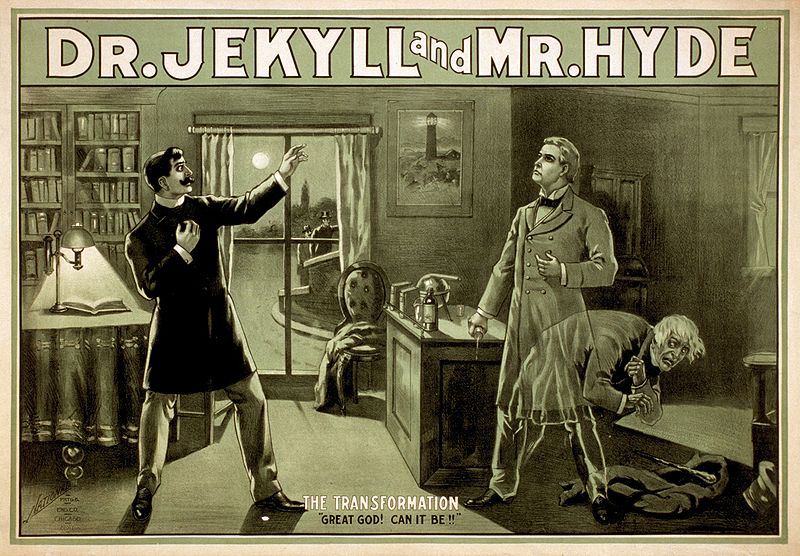Multiple identity
28 Apr 2017
"Split personality": whether this disease exists, how widespread it is and how doctors diagnose dissociative disorder

By dissociative identity disorder (or multiple personality disorder) is understood a set of mental disorders, in particular memory failures, impairments of consciousness and a sense of personal identity that lead to the fact that a person's personality is divided. Because of this, it seems that in one person there are several persons who may have different sex, age, social status, character. Simply put, it can be called a split personality, although one person can include a much larger number of "characters".
This disorder is considered quite rare, and very debatable is the question of the legality of this concept. Despite the fact that dissociative identity disorder is included in the ICD (International Classification of Diseases, Traumas and Causes of Death), in a number of countries doctors and scientists deny the existence of this disease
To improve your mental activity – Selank, Afobazole, Picamilon.
History and criticism of the concept
The description of this disorder has a fairly long history. The first case of dissociative personality disorder was described in the 16th century by the Swiss doctor, philosopher and alchemist Paracelsus. In his writings there are records of a woman who believed that she had someone stealing money, but in fact she was spending money on her second identity, which she did not know about.
In our time, a surge of interest in this problem is largely determined by the mainstream: this topic often appears in feature films, remember at least the same "Fight Club". Daniel Knight's book "Multiple Minds of Billy Milligan" is widely known, based on the real story of a man who had 24 different personalities. These facts lead to the fact that in recent years there has been an opinion among specialists about partially iatrogenic (that is actively provoked by intensified activity of psychotherapists who actively popularize, "untwine" the topic of such disorder, thereby attracting new clients and increasing their incomes) Pathology. In addition, the clinical reliability of this disorder can be questioned due to the fact that almost all cases described are closely related to legal practice and forensic psychiatric examination. For example, American Juanita Maxwell had six personalities, one of whom killed an elderly woman. As a result, Juanita was sent to a psychiatric hospital for treatment.
Establishing diagnosis
In the diagnosis of multiple personality disorders, it must first be differentiated with other dissociative disorders, such as an avoidance reaction or psychogenic amnesia. There are, of course, cases where split personality is only a game of fantasy, and not a disease, because, indeed, there are individuals who are predisposed to react in this way to some events in their lives. In forensic psychiatric practice, this can be a simulation.
As for deeper pathologies, say schizophrenia, then in that case, of course, the diagnosis should be differentiated. In patients with schizophrenia, there is often a belief in the presence of many different ego. Strictly speaking, schizophrenia is the splitting of personality. But here it is important to note that in our case we are exploring deep mental mechanisms that can lead to multiple personality disorder, that is, the phenomenon of dissociation-splitting off. And with schizophrenia, the phenomenon of splitting takes place, when the very core of the personality is destroyed, besides, in this case there are always a number of other phenomena: a violation of thinking, hallucinations.

In addition, when diagnosing a diagnosis, the possible connection between the onset of symptoms of dissociative disorder with the use of drugs or alcohol must be excluded, since in these cases completely different, exogenous mechanisms for the development of the pathological process can be involved. Some psychoactive substances are called "dissociatives" for this peculiar effect of a change in consciousness.
How is multiple personality disorder diagnosed? What is done for this, in addition to clinical observations and questionnaires? This, above all, the method of hypnosis, from medical methods - amytal-caffeine disinhibition. Here it plays a diagnostic character: a person is immersed in a special state when the subcortical structures hidden in everyday life are disinhibited. The patient, being in a euphoric-relaxed state, informs about himself information that was previously inaccessible either due to psychogenic amnesia or repression, or were concealed consciously. This method can be used not only with diagnostic, but also with a therapeutic purpose (for example, in patients in catatonic stupor). In addition to medical indications, disinhibition is widely used by various special services, where it appears as the "serum of truth" and serves to obtain the necessary (and truthful!) Information.
Causes of Dissociative Identity Disorder
Concerning the etiology, the origin of this disorder opinions converge: it is assumed that the conditions conducive to the development of this condition are most often severe, traumatic situations associated with violence. It refers to physical, sexual or psychological violence, suffered in childhood, that is, such a delayed version of the response to a psychotrauma. Approximately 80% of patients manage to find out that in childhood they had episodes of violence or incest or some other severe stressful situations.
There is also the so-called personal predisposition. After all, not every person will react to violence in this way. What else is needed for this? It should be a light personality that is capable of such dissociative response mechanisms. In our domestic psychiatric tradition, such individuals are considered within the framework of a hysterical disorder. This is usually quite demonstrative people, prone to a certain theatrics, loving to make a vivid impression on others and to be always in the center of attention.
In some works, attention is focused on a certain organic inferiority of the nervous system. In particular, there are observations according to which deviations in the encephalogram were observed in 25% of patients with this diagnosis who were in the field of view of psychiatrists. They had changes characteristic of the patient with temporal epilepsy. Thus, the characteristics of the brain can also become a factor that leads to a dissociative identity disorder.
As for the clinical features, it is worth noting the interesting fact: when examining patients usually do not reveal anything unusual in mental status, except perhaps amnesia of certain moments (namely those when one person replaced another, and the dominant personality does not remember what preceded This). The nature of the behavior of the patient's personalities can be so different, the changes can be so sharp that switching can occur within a few seconds, and amnesia can occur in such brief periods of time. But more than that, amnesia can not always happen: a person remembers what happened to him, although his other personality was active; Several personalities seem to coexist in real time.
To various kinds of bifurcations and stratifications of personality can lead experiments with psychedelics, which in themselves are dissociatives. In the fifties of the last century, they tried to experiment with these drugs for scientific purposes, in order, for example, to recreate the model of schizophrenia. But nothing good has ended, the damage ultimately exceeded the benefits of these experiments, some volunteers who participated in them, never managed to return to their previous state.
Multiple Individuals
The range of connections of this disorder with other diseases is very wide. Since there are several individuals, they can be as mentally healthy in themselves individually, and each of them may or may not have any degree of pathology. Pathologies can be very different: from mood disorders and anxiety to mental retardation. Individuals also differ in their cognitive functioning: they may have different IQs. Sometimes it even happens that different personalities require glasses with different diopters, that is, it comes to differences not only in psychological, but also in physiological indicators.

In order not to be confused with personalities, they are given certain names or some functional characteristics, let's say "defender". Accordingly, they can differ by sex and nationality and can refer to different families. The famous American psychologist Eric Berne came up with the theory that each person has a child, a parent and an adult. And in our case it often happens that one of the subpersonalities refers to a child, someone cares, and someone protects. Thus, stressful situations are played out, which could serve as a trigger mechanism for the onset of this disorder, but they recoup in a sufficiently safe manner. In order to avoid an unbearable burden of the situation, a person seems to think up several roles, his psychological defense mechanism tries to outplay this stressful situation in the safest possible way.
Switching between individuals usually happens somehow so unexpectedly and dramatically, up to the fact that one person has entered the train on the subway, and another person has left on another station. There are no clear mechanisms for the transition of one person to another, just like the periodicity of their change.
Statistics of morbidity
According to general statistical data, about forty thousand cases of dissociative personality disorder have been described. But this number included a lot of dubious cases from a serious clinical point of view, which psychoanalysts, psychotherapists and psychologists, who are not experts in the field of psychopathology, were engaged in, and it is difficult to draw unambiguous diagnostic conclusions from their descriptions. In addition, there are 350 officially registered case histories with the established diagnosis of multiple personality disorder (column in ICD-10: F.44.8).
Recent research shows that this disorder is not as rare as previously thought. The most frequent cases are in adolescence, in young people, and this disease occurs in women with a large preponderance - the ratio here is about 1 to 10. And already there are genetic data suggesting that this disease can be hereditary: near the closest relatives Who are ill, that is, relatives of the first degree of kinship, also have a predisposition to such pathologies.
There is an opinion, in particular, in the West, that such a disorder should be considered not a disease, but a variant of the norm. This is just an existential state of the multiple personality, which is not uncomfortable, does not cause any social consequences, and "individuals", respectively, do not seek help, therefore, they are not subject to involuntary treatment. An example is the bestseller "When a rabbit howls" by the authorship of Truddy Chase, who had symptoms of this disorder. She refused to integrate subpersonalities into a single whole, claiming that all her personalities exist as a collective, they are all dear to her, and she would not want to part with them.
Prognosis and treatment
In psychiatry, there is one general rule: the earlier the frustration begins, the worse the social prognosis. Specialists note that dissociative identity disorder, when compared with other personality disorders, is considered to be the most severe and chronic. Recovery is usually not complete. This is due to the fact that, as mentioned above, each of the personalities may have their own mental disorders, including other dissociative disorders.
The main method of treatment is psychotherapy - in particular, cognitive and rational psychotherapy, aimed at developing criticism for one's condition. These are methods aimed at changing stereotypes of thinking, inappropriate thoughts, beliefs. This is a structured learning, which includes the training of consciousness. Specialists in the field of behavioral psychology are engaged in such therapy. Therapies include group psychotherapy, family therapy, for example, and everything related to the criticism of the conflicts underlying the need for a multitude of personalities. That is, it is important to try, although it is very difficult, to reproduce all possible traumas that contribute to the onset of disorders, and to respond to them.
All methods are reduced to attempts to integrate all "split" individuals into one. And to collect the necessary information, since these are all repressed things, you can use hypnosis and conversation under disinhibition. But hypnosis is a double-edged weapon: it can be very damaging, the impact must be straightforwardly jeweled.
There is an insight-oriented psychodynamic therapy that lasts for years. It is also aimed at overcoming the traumatic situation. The subtlety is that a psychotherapist who deals with such patients must turn to each person in turn, work with each of them, take them equally, respect them, in no case take one side if there is an internal conflict.
As for the drug treatment, it is exclusively symptomatic and is directed only at some secondary disorders that occur. Suppose, with depression and anxiety, respectively, antidepressants and tranquilizers are used.
Disease of Western civilization
We do not have enough data to unambiguously attribute dissociative disorders to some cultural peculiarities. Some nations - Eskimos, Malays - there are states when they are as if possessed by a certain creature (for example, amok). But as for the disorder in the form of a multiple personality, it is the prerogative of the Western world. This is, as it were, a model of a modern type of response to certain situations: the cult of self-sufficiency of the individual is developed in the West, a careful attitude towards man as an individual is declared. And therefore, even overcoming unbearable stressful situations, a person does not just remain a person, but he multiplies as a person. That is, it is not just a way to help yourself, but a way to express yourself to some extent.
In this disorder, there is a definite - though paradoxical - narcissism. After all, it's beautiful, it's unusual, it leads to the training of some functions that are not in demand in real life. Man, as it were, leads a kind of role-playing game with himself, experiencing a false sense of self-sufficiency. But in the end social ties begin to suffer, because in the modern world and one individual person often there are problems with integration into society, not to mention the multiple shoots that bud off from the mother-soul.

 Cart
Cart





